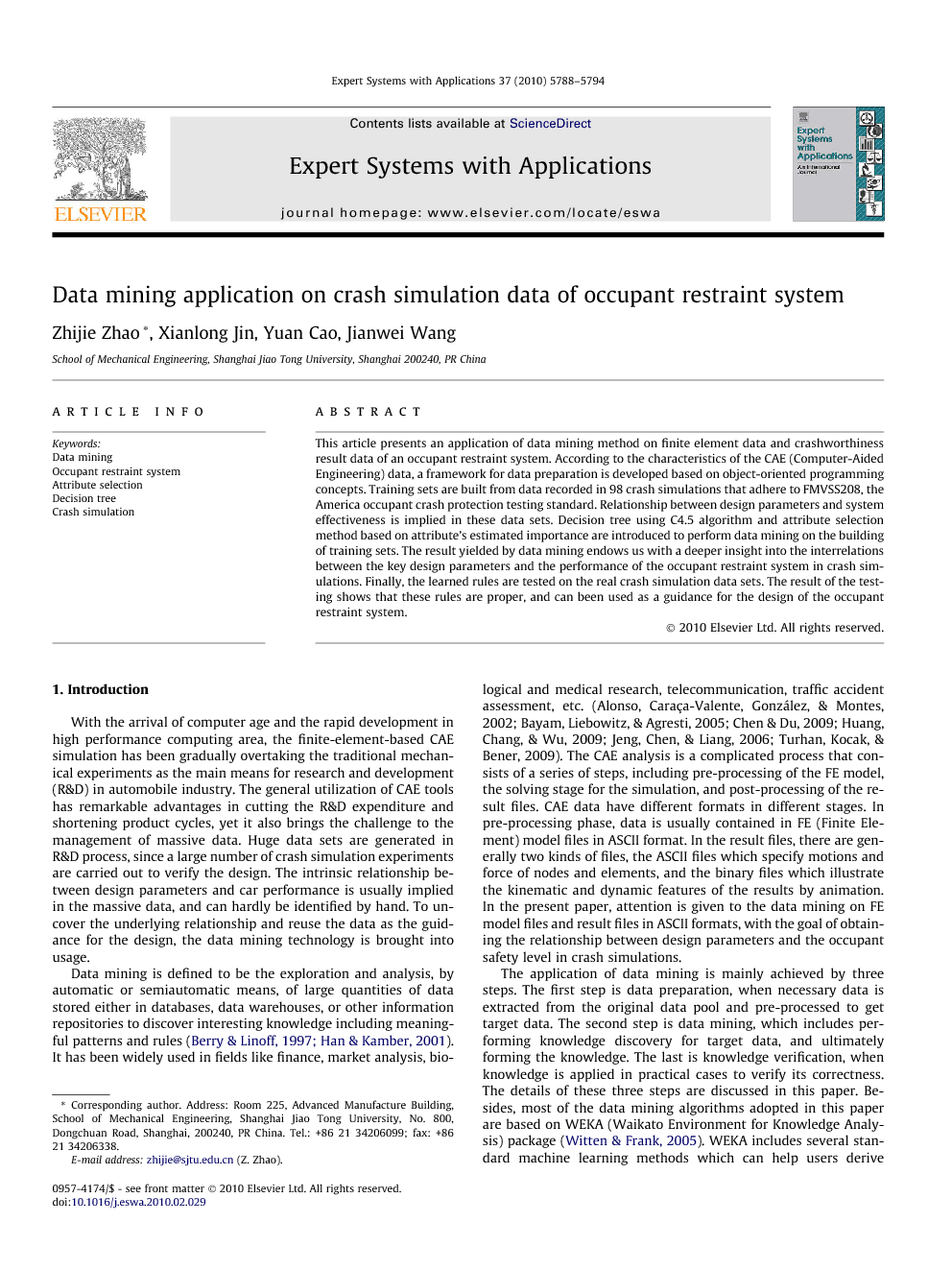This article presents an application of data mining method on finite element data and crashworthiness result data of an occupant restraint system. According to the characteristics of the CAE (Computer-Aided Engineering) data, a framework for data preparation is developed based on object-oriented programming concepts. Training sets are built from data recorded in 98 crash simulations that adhere to FMVSS208, the America occupant crash protection testing standard. Relationship between design parameters and system effectiveness is implied in these data sets. Decision tree using C4.5 algorithm and attribute selection method based on attribute’s estimated importance are introduced to perform data mining on the building of training sets. The result yielded by data mining endows us with a deeper insight into the interrelations between the key design parameters and the performance of the occupant restraint system in crash simulations. Finally, the learned rules are tested on the real crash simulation data sets. The result of the testing shows that these rules are proper, and can been used as a guidance for the design of the occupant restraint system.
With the arrival of computer age and the rapid development in high performance computing area, the finite-element-based CAE simulation has been gradually overtaking the traditional mechanical experiments as the main means for research and development (R&D) in automobile industry. The general utilization of CAE tools has remarkable advantages in cutting the R&D expenditure and shortening product cycles, yet it also brings the challenge to the management of massive data. Huge data sets are generated in R&D process, since a large number of crash simulation experiments are carried out to verify the design. The intrinsic relationship between design parameters and car performance is usually implied in the massive data, and can hardly be identified by hand. To uncover the underlying relationship and reuse the data as the guidance for the design, the data mining technology is brought into usage.
Data mining is defined to be the exploration and analysis, by automatic or semiautomatic means, of large quantities of data stored either in databases, data warehouses, or other information repositories to discover interesting knowledge including meaningful patterns and rules (Berry and Linoff, 1997 and Han and Kamber, 2001). It has been widely used in fields like finance, market analysis, biological and medical research, telecommunication, traffic accident assessment, etc. (Alonso et al., 2002, Bayam et al., 2005, Chen and Du, 2009, Huang et al., 2009, Jeng et al., 2006 and Turhan et al., 2009). The CAE analysis is a complicated process that consists of a series of steps, including pre-processing of the FE model, the solving stage for the simulation, and post-processing of the result files. CAE data have different formats in different stages. In pre-processing phase, data is usually contained in FE (Finite Element) model files in ASCII format. In the result files, there are generally two kinds of files, the ASCII files which specify motions and force of nodes and elements, and the binary files which illustrate the kinematic and dynamic features of the results by animation. In the present paper, attention is given to the data mining on FE model files and result files in ASCII formats, with the goal of obtaining the relationship between design parameters and the occupant safety level in crash simulations.
The application of data mining is mainly achieved by three steps. The first step is data preparation, when necessary data is extracted from the original data pool and pre-processed to get target data. The second step is data mining, which includes performing knowledge discovery for target data, and ultimately forming the knowledge. The last is knowledge verification, when knowledge is applied in practical cases to verify its correctness. The details of these three steps are discussed in this paper. Besides, most of the data mining algorithms adopted in this paper are based on WEKA (Waikato Environment for Knowledge Analysis) package (Witten & Frank, 2005). WEKA includes several standard machine learning methods which can help users derive useful knowledge from data sets that are otherwise too large to be analyzed by hand
This paper presented the application of data mining technique on crash simulations of the occupant restraint system. The classification and prediction of the WIC values was a successful attempt for the reuse of the increasing CAE crash worthiness simulation data.
Based on the object-oriented programming method, we did data preparation for the FE model and the simulation results, adopted attribute selection and decision tree in the data mining process, and obtained the relationship between key parameters of the occupant restraint system and the value of WIC. Furthermore, the knowledge obtained was verified to be practical and valuable, and can be considered as a useful guidance to the engineers in the conceptual design process of vehicles


